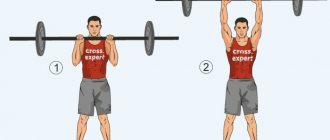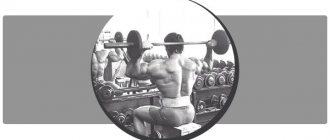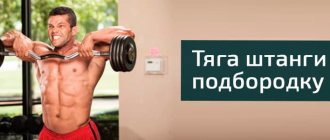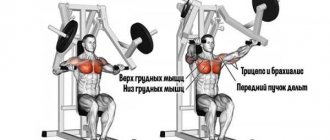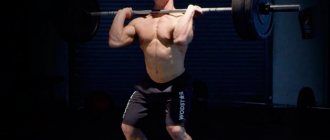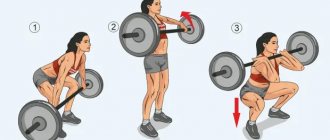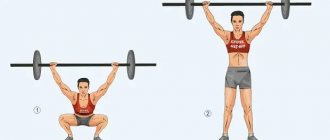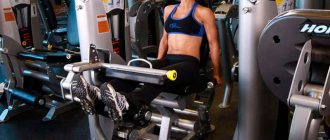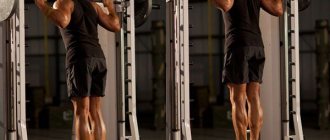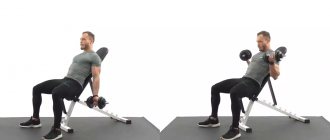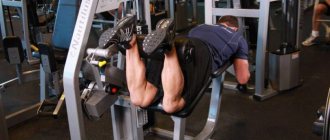The military press is a regular bench press. And the army one is a standing shoulder press, also known as a chest press, or a standing barbell press. The exercise is basic, used not only in bodybuilding, but also in the training of weightlifters and powerlifters. Quite popular, but considered controversial; many athletes believe that it is the cause of spinal injuries, hernias and protrusions. When done correctly, this is not the case. On the contrary, the movement teaches how to stabilize the spine under load, and is very useful for anyone who wants to find a balance between the development of physical qualities and the beauty of the body.
Working muscles
The movement is carried out by the triceps, the anterior and middle heads of the deltoid muscles and partly the posterior deltoid. The muscles of the legs, buttocks, and core work as stabilizers. It is a mistake to think that the military press is an exercise that involves the calf muscles. It is a technical fault if the lifter pushes the weight upward with their legs. If performed correctly, the result will be a shwung; if performed incorrectly, it will be a mediocre imitation.
Some articles actually claim that this movement helps pump up your breasts. In fact, the pecs contract, acting as a shoulder stabilizer, and gradually stretch as the lifter lifts the bar behind his head. But the load cannot be considered sufficient for their hypertrophy. Significant confusion has also arisen because many authors of articles confuse the military-style bench press with the army one. A military-style press is usually called a bench press without supporting your legs, and a military-style press is a standing press.
It is not possible to turn off the stabilizers while standing. Therefore, it is better to leave ideas about performing this movement in Smith without implementation. The Smith machine is a fixed barbell with a trajectory that is exclusively suitable for seated overhead presses, not chest presses. Some machines simulate an elliptical path to make pressing movements more natural, but not every shoulder can work in this exact path. Therefore, it is better not to use the Smith machine option.
Turning off stabilizers from work in basic exercises is a very irrational exercise. Athletes make a base in order to develop all the muscles of the body and activate neuromuscular connections, and not in order to later think about how exactly to adapt it so that the base is not a base.
Standards[edit | edit code]
Standards of the Russian Powerlifters Union[edit | edit code]
Standing press without undergoing doping control
| Men | |||||||
| Weight category | Elite | MSMK | MS | KMS | I | II | III |
| 52 | 85 | 77.5 | 67.5 | 55 | 47.5 | 42.5 | 35 |
| 56 | 92.5 | 85 | 70 | 62.5 | 57.5 | 47.5 | 42.5 |
| 60 | 100 | 90 | 80 | 67.5 | 62.5 | 55 | 50 |
| 67.5 | 107.5 | 100 | 87.5 | 75 | 67.5 | 62.5 | 55 |
| 75 | 115 | 110 | 95 | 80 | 72.5 | 67.5 | 60 |
| 82.5 | 122.5 | 115 | 102.5 | 85 | 77.5 | 70 | 62.5 |
| 90 | 135 | 125 | 110 | 92.5 | 80 | 75 | 67.5 |
| 100 | 157.5 | 140 | 122.5 | 105 | 87.5 | 82.5 | 75 |
| 110 | 165 | 152.5 | 130 | 112.5 | 100 | 92.5 | 82.5 |
| 125 | 177.5 | 162.5 | 140 | 120 | 112.5 | 100 | 92.5 |
| 140 | 187.5 | 170 | 152.5 | 135 | 122.5 | 107.5 | 100 |
| 140+ | 195 | 177.5 | 160 | 142.5 | 135 | 122.5 | 105 |
| |||||||
| Weight category | Elite | MSMK | MS | KMS | I | II | III |
| 52 | 65 | 57.5 | 52.5 | 40 | 35 | 32.5 | 27.5 |
| 60 | 72.5 | 65 | 60 | 47.5 | 40 | 35 | 32.5 |
| 67.5 | 77.5 | 72.5 | 65 | 57.5 | 45 | 40 | 37.5 |
| 75 | 95 | 77.5 | 72.5 | 62.5 | 52.5 | 47.5 | 45 |
| 75+ | 107.5 | 95 | 77.5 | 67.5 | 62.5 | 57.5 | 52.5 |
Standing press with doping control
| Men | |||||||
| Weight category | Elite | MSMK | MS | KMS | I | II | III |
| 52 | 75 | 67,5 | 55 | 45 | 40 | 30 | 27,5 |
| 56 | 82,5 | 75 | 60 | 52,5 | 45 | 40 | 30 |
| 60 | 92,5 | 80 | 70 | 57,5 | 52,5 | 45 | 37,5 |
| 67.5 | 100 | 87,5 | 75 | 65 | 57,5 | 52,5 | 45 |
| 75 | 107,5 | 95 | 82,5 | 72,5 | 65 | 57,5 | 50 |
| 82.5 | 115 | 102,5 | 92,5 | 77,5 | 67,5 | 60 | 55 |
| 90 | 127,5 | 117,5 | 102,5 | 85 | 72,5 | 65 | 57,5 |
| 100 | 150 | 130 | 115 | 97,5 | 80 | 75 | 65 |
| 110 | 155 | 142,5 | 122,5 | 105 | 92,5 | 82,5 | 75 |
| 125 | 165 | 152,5 | 132,5 | 112,5 | 102,5 | 92,5 | 82,5 |
| 140 | 175 | 162,5 | 142,5 | 125 | 112,5 | 100 | 90 |
| 140+ | 185 | 167,,5 | 150 | 132,5 | 125 | 110 | 97,5 |
| |||||||
| Weight category | Elite | MSMK | MS | KMS | I | II | III |
| 52 | 52,5 | 40 | 40 | 35 | 30 | 25 | 22,5 |
| 60 | 55 | 47,5 | 47,5 | 37,5 | 32,5 | 27,5 | 25 |
| 67,5 | 60 | 55 | 55 | 47,5 | 37,5 | 35 | 30 |
| 75 | 67,5 | 60 | 60 | 50 | 47,5 | 42,5 | 37,5 |
| 75+ | 80 | 67,5 | 67,5 | 60 | 52,5 | 47,5 | 45 |
Benefits of the Military Press
To begin with, this movement did not come from the training of US Navy SEALs, as is commonly written everywhere in RuNet, but as a traditional element of training weightlifters. The SEALs really do it, since a good military press will help both throw a bag onto a support and pull out a wounded comrade if something happens. But it is impossible to say for sure who “invented” the exercise. Lifting weights overhead was known to the ancient Greeks, judging by the frescoes, and has always been considered a good developmental exercise.
The military press allows you to develop not so much the strength of the shoulders and triceps themselves, but rather the synergy in the movement of the legs, body, and arms. In addition, it allows you to increase the strength of the entire upper body precisely due to stabilization. It also serves as an excellent special-preparatory movement for a good half of bench press exercises, and partly for strength-speed exercises, such as clean and jerks.
All this has led to the high popularity of the exercise in modern times. In fact, it was not powerlifting or bodybuilding that “infected” the masses with this movement, but CrossFit. When many people came to CrossFit boxes in order to become as cool as those guys in the video, they discovered that they lacked not only strength indicators, but also endurance, as well as banal amplitude in the joints. The military press helps you develop all the necessary movements in CrossFit, from throwing medicine balls from the chest to weightlifting clean and jerks. It also serves to stabilize the shoulder joint in movements performed on the bar.
The military press was also respected by old school bodybuilders. Most of them trained in one way or another with coaches who came from Soviet weightlifting. In this form, lifting weights overhead is a basic movement.
The benefits of the exercise do not end with its applied significance for various disciplines. Being basic, it involves most of the muscles of the upper body. This allows the athlete to effectively build muscle mass and activate neuromuscular connections, as a result, the gain will actually happen faster than if you do only isolation in the gym.
In addition to the shoulders, the movement works great on the triceps. It allows you to change the shape of your hands. Therefore, the military bench press is often given to girls who want to quickly tone their arms, no matter how paradoxical it may sound.
With the correct technique, movement serves as an excellent prevention of problems arising due to insufficiently active blood circulation in the cervical-collar area. A number of sources mention that the military bench press is a prevention of trapezius hypertonicity in security forces and headaches associated with muscle spasms.
Important: all the benefits of the military press are revealed only when the exercise is performed using the correct technique
It's the STANDING PRESS, baby!
What is unique about the standing barbell press?
This exercise is basic for pumping the deltoid muscles. Due to the fact that the work is carried out with free weight, the stabilizer muscles are also tensed during the exercise.
By regularly performing standing barbell presses, you can increase the strength of the shoulder girdle muscles.
During the exercise, the shoulders, pectoral muscles, triceps and back are included. The abdominal muscles, legs, and torso extensors act as stabilizers.
Disadvantages of the exercise
For beginners, the movement has two serious disadvantages:
- Possibility of injury due to technical violations;
- Risk of falling
Some athletes simply do not have time to “unhook” their hands from the apparatus and therefore fall back along with the barbell. This usually happens if the weight taken is too heavy. For novice athletes, movement carries many dangers, especially if a person cannot adequately assess training volume. We are not talking about injuries and falls. Many athletes really want to build up their shoulders faster, so they do a monstrous amount of work on them. This causes inflammation in soft tissues and pain.
They say that the reason is the military press itself, and they forbid doing it. But in fact, the reason is the abundance of different presses, and insufficient time and resources of the body for recovery.
A beginner whose strength is not yet sufficient to adequately stabilize the lower back in an exercise may also experience a back injury. Usually this is a vertebral displacement, protrusion or hernia. It is impossible to assume that this movement alone is the cause. In practice, there are many more reasons, and one of them is weakness of the anterior abdominal wall. Until the abs become stronger, it is recommended to wear an athletic belt. But this is not a panacea. The skill of keeping your back neutral will still have to be developed, no matter how much you would like to exercise safely all your life using only a belt.
Hand injuries are common due to improper technique. Many people do not place the bar in the middle of the palm, and do not provide even pressure, but simply try to redistribute the weight so that it is comfortable to lift. This is not always optimal for the wrists. Wrist bandages partly solve the problem of such athletes.
Standing Barbell Press. Shoulder Exercise.
Execution technique
This is a technically difficult exercise. Before performing it, you need a full joint warm-up, and you just need to activate the entire shoulder girdle. During the warm-up, you need to perform several series of circular rotations forward and backward.
The movement is performed as follows:
- you need to set the racks to a height that is suitable for a front squat. The bar should rest freely on the chest;
- the grip is shoulder-width apart, the athlete grabs the barbell from both sides, the grip is quite tight, then the chest is brought under the bar and the athlete extends his legs, removing the barbell from the racks;
- moving away from the racks looks like a classic squat. After this, the athlete tightens his abs, stabilizes his lower back, rests his feet on the platform, and in one movement along an elliptical path presses the barbell upward;
- the correct trajectory of the projectile is upward in an arc behind the head, and not straight ahead;
- lowering also occurs smoothly;
- touching the chest in each movement is required only if the athlete works without pain or discomfort. Lowering itself is not a necessary element of the exercise.
After completing the approach, the barbell returns to the racks.
Army press. Standing barbell press and seated barbell press
Training programs
The military press is added to the beginning of shoulder training. As a rule, they are trained either on a separate day or with legs.
The most popular split programs:
| Shoulders on a separate day | |
| Exercise | Sets x reps |
| Standing barbell press | 4х15,12,10,8 |
| Seated dumbbell press | 4x12 |
| Wide grip pull | 4x12 |
| Dumbbell swings while standing to the sides | 3x15 |
| Bent over dumbbell swings | 4x15 |
| Arm raises in the rear deltoid machine | 4x15 |
| Legs+shoulders | |
| Exercise | Sets x reps |
| Squats | 4х12,10,8,6 |
| Leg press in the simulator | 3x12 |
| Bending in a lying machine | 4x15 |
| Bend one leg while standing in the simulator | 4x12 |
| Standing barbell press | 4х15,12,10,8 |
| Wide grip pull | 4x15 |
| Side bend swings | 4x15 |
Recipes for healthy eating
Quinoa with tomatoes
- 1.75 g Protein
- 1.61 g Fat
- 8.25 g Carbohydrates
- 52 kcal
60-70 min.
- #vegetarian dish
- #second course
- #dietary
- #breakfast
- #baking
- #quinoa
- #low calorie
- #dinner
- #olive oil
- #tomato
- #cheese
- #dinner
- #spinach
Other recipes
Technical errors
Wrong trajectory
Some people manage to make this movement into a parody of the bench press. They press straight up at the highest point, pushing the barbell away from the body. This turns out to be a rather traumatic variation for the shoulders, which, as the weight increases, also becomes a cause of falls. Another trajectory error is placing the barbell sharply behind the head; this option is not acceptable because it contributes to unnatural overload of the cervical spine. The third trajectory error is the “nose press,” that is, performing the exercise at half the amplitude.
A hodgepodge of styles and exercises
Some athletes confuse this movement with the barbell overhead press due to technique. They do not press their forearms to the body, but do all the work by pushing the weight away from themselves and moving it behind the head. In this case, the elbows are spread to the sides, and the shoulders at the start are parallel to the floor. Everything would be fine if this particular initial position did not cause subacromial syndrome. Using this technique is fraught with joint pain.
Big ego
Huge weights lifted up look cool. But then treating inflammation of the ligaments and muscle tears is not at all as great. Working weights should be increased only when the movement technique allows them to be increased. Everything else is still superfluous.
Engaging your legs, back, and core
Some athletes, instead of bench presses, perform a half-push, a push-up, anything to push the weight with their legs. If you can’t squeeze the barbell smoothly with your hands, you should simply reduce the weight of the weight. It is not necessary to work with the help of the body and legs.
Heel-to-toe rolls
Many people find it difficult to hold weight without losing balance during exercise. Such people should try to carefully maintain their balance by placing their weight in the middle of the arch of the foot. If this doesn’t work out and all you can do is roll, you should switch to a seated press and simultaneously work on developing the muscles of your legs and core.
Excessive training volume
This is common for all beginners. It seems to them that the program is for hacks, and they train less than everyone else in the gym. So the person begins to perform all the approaches that, in principle, he can perform. The volume increases significantly, but the intensity stops growing. The athlete experiences pain in his ligaments and joints, he does not get stronger, and his training simply becomes another attempt to overcome himself. Over time, cumulative injuries appear, and the person refuses to exercise.
How often should you lift your shoulders? Supercompensation principle
The training process is divided into 4 phases:
- Injury . Here the muscles receive stress, which is a prerequisite for eventual muscle growth;
- Recovery . Muscles and other body systems return to their pre-training state. During the recovery phase, training is ineffective;
- Supercompensation . The standing press in bodybuilding only works if used in this phase. The body creates a muscle reserve in case of repeated training. Only here is it possible to observe the principle of progression of loads in the medium and long term;
- Loss of super compensation . If an athlete has not trained for a long time, the body stops spending energy on maintaining reserves, and a rollback occurs to the pre-training state.
The training schemes are clearly shown in this diagram:
The diagram shows how entering the supercompensation phase allows an athlete to grow at an incredible rate. This is the maximum that exists in natural bodybuilding (article about how quickly muscles grow in a natural).
Read more about supercompensation in bodybuilding here.
You can find out about the progression of loads here.
Still confused about how to use the standing press in bodybuilding? Share your experience in the comments! Don’t forget to save the article so as not to lose valuable material, and tell your friends about effective training.
See you again!
Share link:
- Click to share on Twitter (Opens in new window)
- Click here to share content on Facebook. (Opens in a new window)
